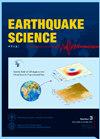High-resolution 3D S-wave velocity structure in northwestern Sichuan-Yunnan Block derived from ambient noise tomography
IF 4.1
4区 地球科学
Q3 Earth and Planetary Sciences
引用次数: 0
Abstract
The Sichuan-Yunnan Block is located on the southeastern margin of the Qinghai-Xizang Plateau and has frequent seismic activity on the western border, posing a potential threat to human society and economic development. Therefore, it is important to understand its geological evolution, assess earthquake risks, and formulate scientific and reasonable disaster prevention and mitigation strategies. Using 23 months of continuous ambient noise records from 81 seismic stations, we obtained 1248 phase-velocity dispersion curves of the fundamental Rayleigh wave at 5–50 s. The three-dimensional (3D) S-wave velocity structure in the northwestern Sichuan-Yunnan Block was obtained by pure-path and depth inversion. The results show that three low-velocity anomalous bands were distributed nearly north-to-south (N-S) at depths of 10–35 km. The overall shape of the low-velocity channel gradually shifted from southeast to southwest because of the influence of the Panzhihua high-velocity blocks. The low-velocity strip consists of three branches, with the first branch extending southwest from the northern part of the Lancangjiang Fault. The second branch is distributed in the N-S direction and is blocked by two high-velocity bodies near the Longpan-Qiaohou and Honghe faults. The third branch crosses the research area from N-S and gradually extends from southeast to southwest and from shallow to deep. The three low-velocity anomaly distribution areas are likely the most severely deformed areas of the collision between the Qinghai-Xizang Plateau and Yangtze Block. The results provide a more detailed understanding of the deep structure of the western boundary of the Sichuan-Yunnan Block crustal low-velocity anomalies and reliable geophysical evidence for the morphology and continuity of crustal flows.
基于环境噪声层析成像的川滇地块西北部高分辨率三维横波速度结构
川滇地块位于青藏高原东南缘,西部边界地震活动频繁,对人类社会经济发展构成潜在威胁。因此,了解其地质演化,评估地震风险,制定科学合理的防灾减灾战略具有重要意义。利用81个地震台站23个月的连续环境噪声记录,得到了1248条5-50 s的瑞利基波相速度频散曲线。通过纯路径和深度反演,获得了川滇地块西北部的三维横波速度结构。结果表明,在10 ~ 35 km深度处,有3条低速异常带呈近北向南(N-S)分布。受攀枝花高速地块的影响,低速河道整体形状逐渐由东南向西南偏移。低速带由三条分支组成,第一条分支从澜沧江断裂北部向西南延伸。第二条分支沿北向南方向分布,在龙盘-桥侯断裂和红河断裂附近被两个高速体阻断。第三支由北向南穿越研究区,逐渐由东南向西南、由浅向深延伸。这三个低速异常分布区可能是青藏高原与扬子地块碰撞变形最严重的区域。研究结果为川滇地块地壳低速异常西界深部构造提供了更为详细的认识,为地壳流动形态和连续性提供了可靠的地球物理证据。
本文章由计算机程序翻译,如有差异,请以英文原文为准。
求助全文
约1分钟内获得全文
求助全文
来源期刊

Earthquake Science
GEOCHEMISTRY & GEOPHYSICS-
CiteScore
1.10
自引率
8.30%
发文量
42
审稿时长
3 months
期刊介绍:
Earthquake Science (EQS) aims to publish high-quality, original, peer-reviewed articles on earthquake-related research subjects. It is an English international journal sponsored by the Seismological Society of China and the Institute of Geophysics, China Earthquake Administration.
The topics include, but not limited to, the following
● Seismic sources of all kinds.
● Earth structure at all scales.
● Seismotectonics.
● New methods and theoretical seismology.
● Strong ground motion.
● Seismic phenomena of all kinds.
● Seismic hazards, earthquake forecasting and prediction.
● Seismic instrumentation.
● Significant recent or past seismic events.
● Documentation of recent seismic events or important observations.
● Descriptions of field deployments, new methods, and available software tools.
The types of manuscripts include the following. There is no length requirement, except for the Short Notes.
【Articles】 Original contributions that have not been published elsewhere.
【Short Notes】 Short papers of recent events or topics that warrant rapid peer reviews and publications. Limited to 4 publication pages.
【Rapid Communications】 Significant contributions that warrant rapid peer reviews and publications.
【Review Articles】Review articles are by invitation only. Please contact the editorial office and editors for possible proposals.
【Toolboxes】 Descriptions of novel numerical methods and associated computer codes.
【Data Products】 Documentation of datasets of various kinds that are interested to the community and available for open access (field data, processed data, synthetic data, or models).
【Opinions】Views on important topics and future directions in earthquake science.
【Comments and Replies】Commentaries on a recently published EQS paper is welcome. The authors of the paper commented will be invited to reply. Both the Comment and the Reply are subject to peer review.
 求助内容:
求助内容: 应助结果提醒方式:
应助结果提醒方式:


